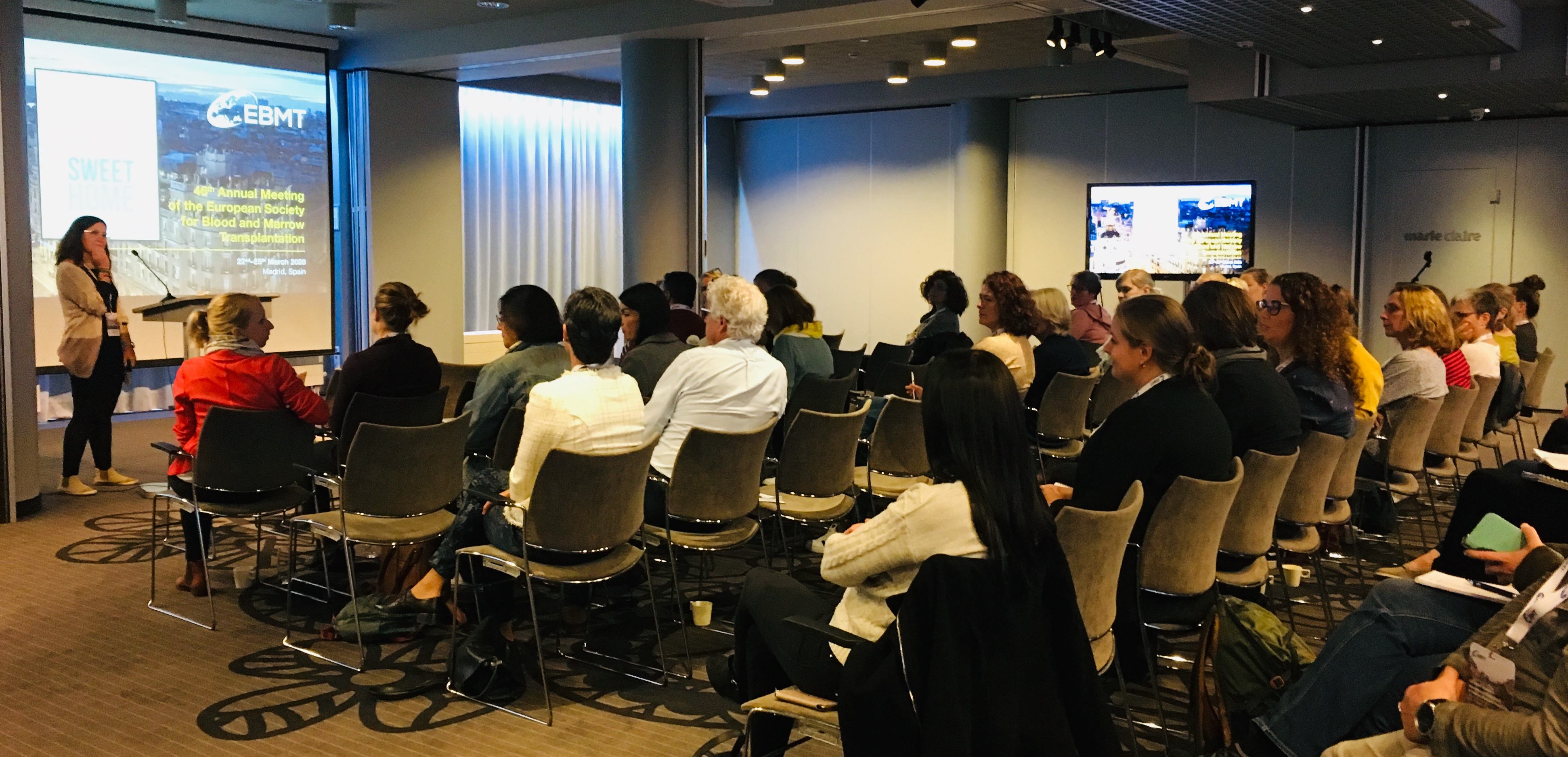
3-4 October 2019 in Amsterdam, The Netherlands
Thursday 3 October - Session III
Summary by Hilda Mekelenkamp, Member of the Nurses Group Paediatric Committee and NG representative to the IEWP, Paediatric Haematology nurse and PhD student, Leiden University Medical Center (LUMC), The Netherlands
- Chronic GVHD Assessment and Care by the Nurse Practitioner - M. Schoordijk
- Endocrine problems after treatment - S. Neggers
- AYA | What are the patients’ needs Patient and physician - A. Kramers & R. Boersma
Marieke Schoordijk explained that acute and chronic graft versus host disease (GVHD) are two different diseases. Chronic (GvHD) is the most common long-term complication and the most important reason for non-relapse mortality and morbidity after haematopoietic stem cell transplantation (HSCT). It affects 30-70% of the patients. This serious complication has a major impact on the quality of life of the patients. Patients have to deal with a chronic disease after being cured from an initial serious disease. An important aspect of nursing care is the regular assessment of GVHD in order to start the right therapy at an early stage. The eGVHD app by UZ Leuven, developed in collaboration with EBMT and NIH, is a useful tool for systematical assessment of organs.
Sebastian Neggers explained the short and long-term effects of cancer treatment and HSCT. The short-term effects are side effects of chemotherapy and/or radiation; long-term effects are complications five years after diagnosis. Late effects are relevant and it is important to look for them. Fatigue is one of the most important late effects of cancer treatment, but be aware of other causes. Sixty-five percent of the late effects are endocrine problems, causing multiple and chronic conditions. Late effects can cause mortality, even 30 years after treatment. It is important to be aware of early ageing among cancer survivors and this needs additional attention from patients, nurses and physicians.
Anita Kramers-de Boer presented with ex adult and young adult (AYA) patient Rosan Boersma about AYA patients’ needs during HSCT. It is important to devote attention to their specific needs by using, for example, a conversation agenda. Rosan shared in an open and honest way her experience during treatment for acute lymphoblastic leukaemia. She realised that patients have their own responsibility and choices in treatment compliance and their fight in mental health. Health professionals need to be able to approach patients about these topics. Nurses can help patients in making a personalised care plan during HSCT, which address wishes for treatment and care in the present and future. This provides some autonomy and control during difficult times throughout treatment. Caring for AYA patients means a delicate balance is required between patients and the healthcare team in order to inspire a holistic care plan and empowerment of the patient.
Friday 4 October – Session I and II
Summary by Helen Jessop, Nurses Group Representative to the ADWP, BMT Coordinator, Sheffield Teaching Hospital, UK
Session I:
- Opening Comments & Welcome - S. Liptrott
- Perception of patients about the insertion of central venous catheter: preparation, functionality and body image - study preliminary results - C. Canaleta Ros
- Re-engineering follow-up care after allogeneic stem cell transplantation: patients’ and clinicians’ perspectives of eHealth enhanced support care - THE SMILE STUDY - S. Valenta & L. Leppla
The sessions were introduced by Sarah Liptrott, Chair of the Nurses Research Committee, who commenced with an overview of achievements over the last year including publications and current submissions.
Christina Canaleta Ros opened her talk by telling us there is a small part of Florence Nightingale in all of us, as Nurses we are all capable of performing research. She discussed the preliminary results of a single centre study comparing patient experiences between central and peripherally inserted central venous catheters utilising a 26-item questionnaire.
Sabine Valenta and Lynn Leppla then presented their exciting collaborative work from Freiburg and Basel in developing an eHealth App for patients post HSCT through the SMILE Project. Through the use of implementation science, the work has led to the development of automated responses to symptoms reported via the App and to a new care coordinator role. They also highlighted the lessons learnt through their journey; the requirement for a team approach, ensuring adequate time and funding, and expansion of context analysis.
Session II:
- How to critically read a paper - N. Gosall
- How to dissect statistics - N. Gosall
Dr Gosall gave us a comprehensive and interesting overview of how to critically read a paper and dissect statistics highlighting the need to identify clear study aims, appropriate study design, identification of the clinical question using PICO. She also explained the importance of analysing statistics and gave examples of what to look for within the data.
The last presentation of the morning was the sponsored symposium where Elisabeth Wallhult gave an interesting talk on veno-occlusive disease including the hot off the press updated position statement by Mohamad Mohty et al detailing preventative and treatment measures.
Friday 4 October – Session III
Summary by Julia Ruiz, EBMT 2020 Annual Meeting Local Nurses Co-Chair, Member Nurses Group Global Education Committee, Quality Manager & JACIE Inspector
Department of Paediatrics, Niño Jesus Children`s Hospital, Madrid, Spain
- Workshop: Turning your ideas into research
On this session we had some very practical issues about how nurses can be supported for research projects by EBMT Study Office presented by Anne Lippinkhof. She reminded us that we have close connections to patients and that this is very valuable for research and wrapped up these ideas with this quote: “The longer I´m in the profession the more experiences shape my life, the more amazing colleagues influence me, the more I see micro and macro power of nursing” from Jon Watson. We had an overview about EBMT and EBMT registry, we are happy to know that when MACRO gets implemented, there will be nursing specific variables that we will be able to use for research. There are several research studies supported: centre-based surveys, such as the ATG survey and protective environment survey; patient-based research, such as the central venous catheter placement study and non-interventional prospective study such as the S-FAST study, a survey about sexual function after transplant.
She went through the phases of study development, that is quite a long pathway, but the most important thing to highlight is to look for a proper research question. The study coordinator works with Nurses Group Research Committee when there is a proposal and they will follow progress of the ongoing studies. So, if you have any new ideas, you can be the principal investigator (PI) of a future study! Look for the research proposal form at the EBMT website, you will find this under the “Nursing” section, click on “Nursing Research Committee” where you can download it, complete it and send it to EBMT Data Office and to EBMT Nurses Group.
Annika Kisch gave us some hints to turn our ideas into research, before diving into the workshop. Study proposals should include a title, an introduction that will state why it is necessary to conduct this study, our primary objective, a short description of the study and the research design.
Participants were divided into 7 groups to enable an interactive process. At the end the research questions were developed and shared about: needs assessment of elderly patients, nutritional aspects about tube feeding versus total parenteral nutrition (TPN), comparing different center practices to prevent spreading bacteria, impact of nurses role in skin cGvHD nursing care and follow-up in adults, daily input study to reduce TPN, effective report of side effects done by patients in ambulatory care having autologous transplants, and effectiveness of sleep quality tools to detect sleep disturbances. We look forward to seeing these research questions progressing towards research studies!
